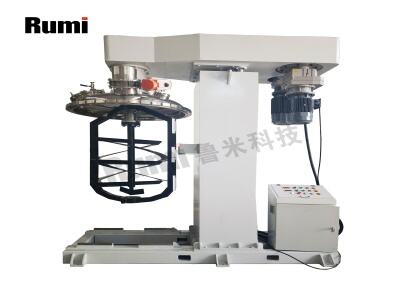Нягт химийн үйлдвэрт олон төрлийн материалын, зуурмай, боловсруулалтын үйл ажиллагааны шаардлагатай нарийн холимог шаардлагатай байдаг. Эдгээр нь тохируулга хийх боломжтой бөгөөд хатуу орчинд тэсвэлдэг тул олон валтай холигч нь хамгийн тохиромжтой шийдэл юм.
Олон төрлийн даалгавар гүйцэтгэхэд олон төрлийн хутгагчийн тохируулга
Олон валцтай холивч нь ижил систем дээр өөр өөр төрлийн хутгагчтай (жишээ нь: өндөр хурдны дисперсчид, бага хурдны яст малт загасны хутгагчид, тойрог холигчид) олон валц бүхий холивч юм. Энэ дизайны ачаар холих үйл явц нэгэн зэрэг олон үйл функцийг гүйцэтгэдэг: хурдан эргэдэг дисперсчид нь цэвэржүүлэх, нунтаг материалыг холих үед бөмбөлгүүдийг задалж, удаан эргэдэг холигчид нь материалыг их хэмжээгээр холих, хананд наалдахыг саатуулдаг. Жишээлбэл, найрлагыг үйлдвэрлэх үед энэ холивч нь бүрэн холигдоогүй смолын анхдагч материалыг холихдоо бат бөх ширхэгийг жигд тархалтанд оруулж, нэг валцтай холивчийн хийж чадахгүй зүйлийг хийдэг. Нэг усны урсгал дээр хэд хэдэн үйлдлийг хийх боломж нь үйл ажиллагааг оновчтой болгоход тусалж, үйлдвэрлэлтийн хугацааг хэмнэнэ.
Нарийн тодорхойлолтоор өөр өөр зуурмаг чанарыг ашиглах
Олон валтай холивч нь бага нарийн шингэнд, мөн өндөр нарийн паст, найрлагатай холимогт зохимжтой байдаг. Холивчийн хурдны зохицуулагч болон моментын хөдөлгүүр нь материалыг холих үед тэдгээрийн онцлогт тохируулан өөрчлөгддөг. Бат бөх бодис эсвэл сэлгэмэг хөнгөвчлөх болон холивчийн вал нь холимгийг сайн холиход тогтмол хүчдэлийг бий болгохын тулд хурд болон хүчээ өөрчилдөг. Ийм төрлийн төхөөрөмжийн олон талт байдал нь тус бүр зориулалтын тоног төхөөрөмжийг ашиглах шаардлагагүй болгодог бөгөөд иймд янз бүрийн найрлага бүхий үйлдвэрт сайн тохирдог.
Батлагийн боловсруулалтанд сайжруулалт хийсэн үр ашиг
Олон валцтай холигчид нь урсгалын зэрэгцээ эргэх үед нийлбэр боловсруулалтыг хамгийн их хурдтайгаар хийх боломжийг олгодог. Тусдаа циклүүдэд тархаагүй, холих, нэгэн төрлийн болгох үйл явцыг дагаж биш, тэдгээрийг нэг циклд нэгтгэх боломжийг олгодог тул материал зөөх, алдагдал, бохирдох эрсдлийг бууруулдаг. Энэ үр ашиг нь туршилтын түвшинд эсвэл томъёоллын хурдан шүүлт, масштабыг тодорхойлох нь онцгой ач холбогдолтой байх жижиг баталгаат үйлдвэрлэлийн түвшинд онцгой ач холбогдолтой. Үйлдвэрлэлийн хэрэглээнд том, олон валцтай системүүдийг автомжуулсан хяналтын самбаруудтай хослуулан температурыг, холих хугацааг тогтмол хянах, баталгаануудын хооронд давтагдах чанарыг хангах боломжтой.
Туслах системтэй нийцэх чанар
Эдгээр холигч нь саван доторхийн систем, халаалтын/хөргөлтийн гилтгээ, материал зөөвөрлөлтийн систем зэрэг нэмэлт дэмжлэг үзүүлэх системтэй хамтдаа хармонич хослох бөгөөд илүү нарийн процедуруудад чухал ач холбогдолтой. Саван доторхийн боломжууд нь өндөр наалдамхай холимог үед агаарын бөмбөлгийг арилгаж, агааргүй герметик болон давслаг үйлдвэрлэхэд чухал үүрэг гүйцэтгэдэг. Халаагч/хөргөгч гилтгээнүүд нь материалын температурыг тогтмол байлгаж, холих үед оновчтой наалдамхай байдлыг хангах эсвэл дулааны эмзэг материалыг хэт халахыг саатуулна. Энэ нь материал түүхий эдийг нийлүүлэхээс эхлээд бүтээгдэхүүнийг гаргах хүртэлх боловсруулалтыг хийх боломжийг олгодог тул олон валтай холигчийг нийт үйлдвэрлэлийн шугамын чухал бүрэлдэхүүн хэсэг болгож байна.
Товчоор хэлбэл, олон валтай холигчид нь хутгагчийн олон төрлийн загвар, өргөн вискозитетийн муж, нэмэлт системүүдийн үр ашигтай интеграцитайгаар батлагдсан ажиллагааг сайжруулах замаар нарийн химийн үйлдвэрлэлийн шаардлагыг хангах боломжийг олгодог. Энэ загвар нь нарийн химийн салбарт тохиромжтой бөгөөд янз бүрийн хэрэглээнд хэрэглэх боломжтой өндөр чанартай үр дүнг бүрдүүлдэг.
 EN
EN
 AR
AR
 BG
BG
 HR
HR
 CS
CS
 DA
DA
 NL
NL
 FI
FI
 FR
FR
 DE
DE
 EL
EL
 IT
IT
 JA
JA
 KO
KO
 NO
NO
 PL
PL
 PT
PT
 RO
RO
 RU
RU
 ES
ES
 SV
SV
 TL
TL
 ID
ID
 LT
LT
 SR
SR
 SK
SK
 SL
SL
 VI
VI
 HU
HU
 TH
TH
 TR
TR
 FA
FA
 MS
MS
 BE
BE
 IS
IS
 AZ
AZ
 BN
BN
 EO
EO
 LA
LA
 MN
MN



